The Desert Northwest
Botanical Expedition to Southern Washington
October 2011
Page 1 - Packwood
Page 2 - The East Slopes >>
Page 3 - Glenwood >>
Page 4 - Big Lava Bed >>
Page 5 - Mt. Hood Country >>
|
So you've heard of Eastern Washington and Western Washington – a perfectly natural division – but where the heck is “Southern Washington?” Well, believe it or not, it isn't just inside my head: Skamania and Klickitat County have a distinctive flora where species more commonly associated with Oregon and points farther south occur, and certain plants common to other parts of the state become rare or disappear. It is this area that I had long wanted to search for interesting forms of various manzanita (Arctostaphylos) species and hybrids that are reported to be there, as well as Ceanothus and other plants. And since I was going to be in the area, I decided I would also spend a half day each in eastern Lewis County, and in Hood River County, Oregon, to visit a few other interesting botanical sites.
Warning: this page contains some intense Arctostaphylos-geekism. I recognize that not everyone is that interested in Arctostaphylos and some may find the details of this report to be less than fascinating. Nevertheless, I think these plants deserve more attention from botanists and gardeners alike, and I wish to highlight the amazing diversity of Arctostaphylos forms and hybrids that can be found even here in our own Pacific Northwest. This doesn't even cover it all, as some of the Arctostaphylos are different again on the Olympic and Kitsap Peninsulas, and in Chelan County. But I digress. Read on, fellow Arctogeeks.
So, off I went (by myself this time) late in the evening so I could camp close to the first area I wanted to explore. I woke up to a cool, foggy, drippy, dark morning in an unofficial campsite along a muddy gravel road just outside the southeast entrance to Mount Rainier National Park. The fog was so thick and the sky so dark that many of my pictures that morning didn't come out well.
|
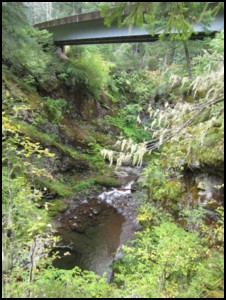
|
The first area I stopped at was a little canyon along Highway 123 just north of where it leaves US 12, where a creek had carved a very deep gorge into the bedrock. Although the plants here weren't extremely exciting here, I was excited just because it was my first look at the Arctostaphylos and they were at least somewhat interesting.
|
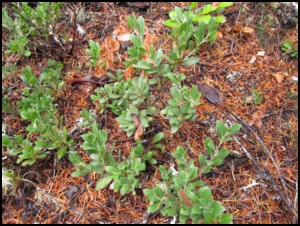
|
Immediately, though, I became confused since I'm not sure whether to call this A. x media or A. nevadensis. It could just as well be either since both are known from this area. Actually, after this trip I am not certain I can always tell A. nevadensis from A. uva-ursi from A. x media in general: certainly some plants in certain areas are obvious, but here distinctions get mighty fuzzy. I was in a fog in more ways than one. Ceanothus velutinus var. velutinus is also common here, the shrubby eastern form that is far more common east of the Cascade Crest: here it jumps over to the west side (not pictured).
|
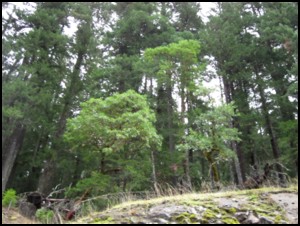
|
This really awful picture (I know it's hard to tell what you're even looking at here - sorry) shows Arbutus menziesii (left) and Quercus garryana (right) along US 12 just east of the junction with Highway 123. Both have isolated disjunct occurrences in a restricted area east of Packwood. I'll have to go back when it isn't so dark and drizzly to explore this area further.
|
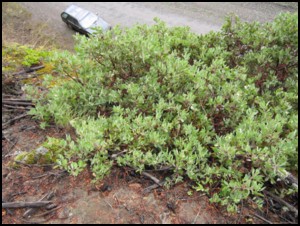
|
This is also a good place to find Arctostaphylos columbiana (hairy manzanita). In particular I was after extra cold-hardiness of high altitude and inland forms such as this one at 2,500' near Laurel Hill. (Yes that's my car, and no it wasn't easy getting to this plant!)
|
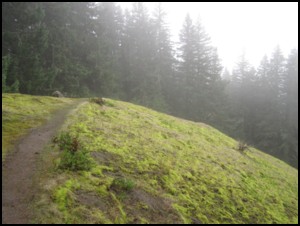
|
Also at Laurel Hill is this peculiar rock outcrop which must have a spectacular view when it isn't foggy and dark. By now it was about 10:30 am but the fog was so thick it still felt like twilight. Just as peculiar as the light, or lack thereof, was the assortment of manzanitas growing on it.
|
|
Arctostaphylos ID quiz, anyone? I think a lot of these would have to be A. x media, but there could be A. nevadensis genes in there as well - who knows?
|
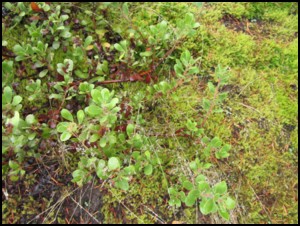
|
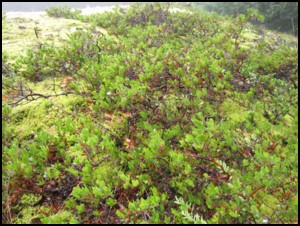
|
So I can almost hear you asking, it's just a bunch of little shrubs on a rock, what's the big deal? I know - Arcto-geekism, what can I say.
|
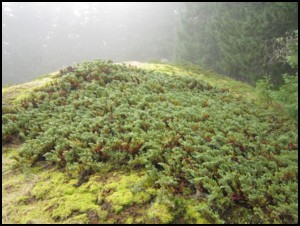
|
On this same outcrop was a single, enormous spreading juniper. This is J. communis, one of the most widely distributed conifers in the world. With so many annoying juniper cultivars blighting everyone's landscapes, it's always cool to see this species in the wild.
|
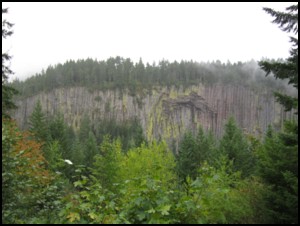
|
Heading farther up US 12, one can stop at the Palisades Viewpoint, where the Clear Fork of the Cowlitz River carved a canyon into an ancient mass of basaltic columns.
|
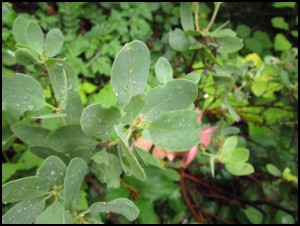
|
There are also some interesting plants growing here, including Ceanothus velutinus again, and this form of Arctostaphylos columbiana which I'm certain must have excellent blue color when it isn't getting soaked with drizzle.
|
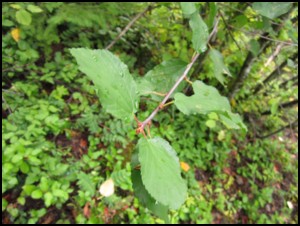
|
Ceanothus sanguineus was also here. I find this species to be relatively less exciting since it's deciduous and not that great in flower, but it may be worth growing for wildlife habitat and hybridization potential.
|
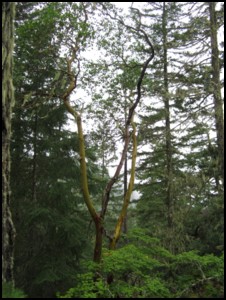
|
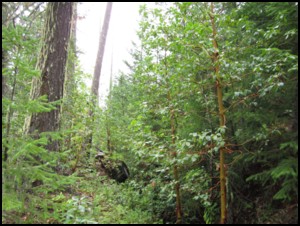
|
A little bit up from here, on another outcrop up a very overgrown forest service road, is possibly the highest grove of Arbutus menziesii in Washington at 2,500'. I have checked these trees several times for seed and never found any. (It may grow a little higher in the Elwha Basin of the Olympic Mountains near Griff Creek; I'll have to check that out sometime.)
|
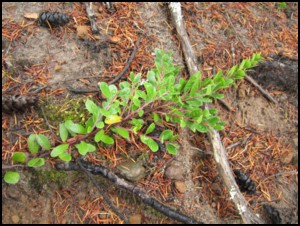
|
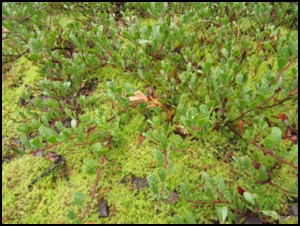
|
But as long as I was here I noted a couple forms of Arctostaphylos I thought were interesting. These would probably both fall within A. uva-ursi, though they may have hybrid genes in them: one with exceptional vigor and giant leaves (to 1 1/4” long), and another with a very open growth habit to 6” tall and oddly spoon-shaped leaves.
|
Page 2 - The East Slopes >>
|